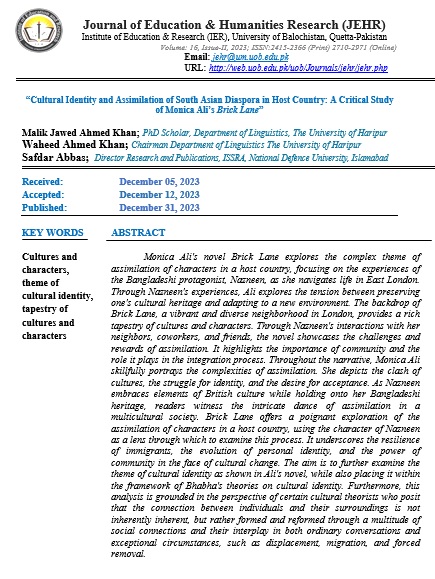Cultural Identity and Assimilation of South Asian Diaspora in Host Country: A Critical Study of Monica Ali’s Brick Lane
Abstract
Monica Ali's novel Brick Lane explores the complex theme of assimilation of characters in a host country, focusing on the experiences of the Bangladeshi protagonist, Nazneen, as she navigates life in East London. Through Nazneen's experiences, Ali explores the tension between preserving one's cultural heritage and adapting to a new environment. The backdrop of Brick Lane, a vibrant and diverse neighborhood in London, provides a rich tapestry of cultures and characters. Through Nazneen's interactions with her neighbors, coworkers, and friends, the novel showcases the challenges and rewards of assimilation. It highlights the importance of community and the role it plays in the integration process. Throughout the narrative, Monica Ali skillfully portrays the complexities of assimilation. She depicts the clash of cultures, the struggle for identity, and the desire for acceptance. As Nazneen embraces elements of British culture while holding onto her Bangladeshi heritage, readers witness the intricate dance of assimilation in a multicultural society. Brick Lane offers a poignant exploration of the assimilation of characters in a host country, using the character of Nazneen as a lens through which to examine this process. It underscores the resilience of immigrants, the evolution of personal identity, and the power of community in the face of cultural change. The aim is to further examine the theme of cultural identity as shown in Ali's novel, while also placing it within the framework of Bhabha's theories on cultural identity. Furthermore, this analysis is grounded in the perspective of certain cultural theorists who posit that the connection between individuals and their surroundings is not inherently inherent, but rather formed and reformed through a multitude of social connections and their interplay in both ordinary conversations and exceptional circumstances, such as displacement, migration, and forced removal.
References
Ali, M. (2003). Brick Lane. Doubleday.
Arikan, S., & K. G. (2010). Double alienation in Monica Ali’s novel Brick Lane. Humanities Sciences, 5(4), 490-505.
Ashcroft, B., Griffiths, G., & Tiffin, H. (2006). The post-colonial studies reader. Routledge.
Bhabha, H. K. (1994). The Location of Culture. Routledge.
Chakravorty, S. K. D. & S. N. S. (2016). The other one percent: Indians in America. Oxford University Press.
Craig,Amanda. (2003). Monica Ali. The Sunday Times Online.
Ethnicities. (2202). Children of immigrants in America. Choice Reviews Online, 39(0).
Fanon, F. (1952). Black Skin, White Masks. Grove Press.
Fernández, I. G. (2009). Representing third spaces. Fluid Identities and Contested Spaces in Contemporary British Literature. Atlantis: Revista De La Asociación Española De Estudios Anglo-Norteamericanos, 31(2), 143–162.
Hall, S., & Du Gay, P. (Eds.). (1996). Questions of cultural identity. Sage Publications, Inc.
Kivisto, P. (2002). Multiculturalism in a global society. Blackwell Publishing.
Marinescu, R. E. (2007). Postcolonial identities: British-South-Asian novelists. Synergy, 2, 88–101.
Monica Ali. (2003). Brick Lane. Doubleday.
Moi, Toril. (1985). Sexual/textual politics: Feminist literary theory. Methuen.
Said, E. (2003). Orientalism. Penguin Classics.
Spivak, G. C. (2023). Can the subaltern speak? In Imperialism (pp. 171-219). Routledge.
Van,A. Gennep.(1909).The rites of passage. University Chicago Press.




